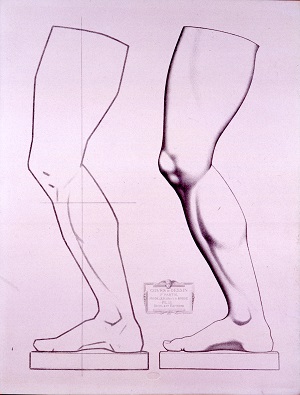Charles Bargue (French, 1826/7–1883)
From the Drawing Course (Cours de Dessin). “Part I: Drawing after Casts (Modèles d’Après la Bosse),” plate I, 25. Paris: Goupil & Cie, 1868.
Leg of Germanicus in Profile, ca. 1868
Lithograph on gray paper, 23 7/8 x 18 1/2 in.
Stamped lower center: COURS de DESSIN Ier PARTIE MODÈLES d’Après La Bosse Pl 25, GOUPIL & Cie EDITEURS
2000.10

Before studying plaster casts or live models, art students usually tried to master the skill of drawing by copying two-dimensional images. They did so on their own or with teachers, with the help of manuals or drawing courses, like Charles Bargue and Jean-Léon Gérôme’s Drawing Course. The first volume of the Drawing Course provided examples of plaster casts, often with a rudimentary abstraction of the general form of the model next to a finished version of the same object for many of the plates. The images were grouped by different body parts so that the pupil could systematically focus on each element in isolation before attempting to reproduce a full human figure. Leg of Germanicus in Profile offers an example of a non-weight-bearing (or “play”) leg of a body in the contrapposto pose (a hallmark of the Greek Classical style). While the antique statue that this leg comes from (currently in the Louvre, Paris) was known as Germanicus when the Drawing Course was created, it has since been re-identified as Marcellus, the Nephew of Augustus.
Bargue began his career as a lithographer, working as a freelancer, first for the publisher F. Sinnet starting about 1847, before joining the renowned art dealership Goupil & Cie around 1858. Although he never received any formal training, Bargue established himself as a skilled copyist, and was selected to serve as the lithographer for the Drawing Course (first published 1868–73), working with renowned painter and instructor Jean-Léon Gérôme. It is likely that Gérôme may have informally provided Bargue with some artistic instruction, as he was once heard referring to the younger artist as one of his “beloved students” (although Bargue was never formally enrolled in the master’s studio).


